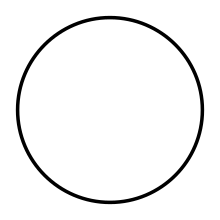| Regular megagon |

A regular megagon
|
| Type |
Regular polygon |
| Edgesand vertices |
1000000 |
| Schläfli symbol |
{1000000}, t{500000}, tt{250000}, ttt{125000}, tttt{62500}, ttttt{31250}, tttttt{15625} |
| Coxeter diagram |
       
        |
| Symmetry group |
Dihedral (D1000000), order 2×1000000 |
| Internal angle(degrees) |
179.99964° |
| Dual polygon |
Self |
| Properties |
Convex, cyclic, equilateral, isogonal, isotoxal |
A megagon or 1 000 000-gon is a polygon with 1 million sides (mega-, from the Greek μέγας megas, meaning “great”).[1][2] Even if drawn at the size of the Earth, a regular megagon would be very difficult to distinguish from a circle.
Regular megagon[edit]
A regular megagon is represented by Schläfli symbol {1000000} and can be constructed as a truncated 500000-gon, t{500000}, a twice-truncated 250000-gon, tt{250000}, a thrice-truncated 125000-gon, ttt{125000}, or a four-fold-truncated 62500-gon, tttt{62500}, a five-fold-truncated 31250-gon, ttttt{31250}, or a six-fold-truncated 15625-gon, tttttt{15625}.
A regular megagon has an interior angle of 179.99964°.[1] The area of a regular megagon with sides of length a is given by
- {displaystyle A=250000a^{2}cot {frac {pi }{1000000}}.}

The perimeter of a regular megagon inscribed in the unit circle is:
- {displaystyle 2000000sin {frac {pi }{1000000}},}

which is very close to 2π. In fact, for a circle the size of the Earth‘s equator, with a circumference of 40,075 kilometres, one edge of a megagon inscribed in such a circle would be slightly over 40 meters long. The difference between the perimeter of the inscribed megagon and the circumference of this circle comes to less than 1/16 millimeters.[3]
Because 1000000 = 26 × 56, the number of sides is not a product of distinct Fermat primes and a power of two. Thus the regular megagon is not a constructible polygon. Indeed, it is not even constructible with the use of neusis or an angle trisector, as the number of sides is neither a product of distinct Pierpont primes, nor a product of powers of two and three.
Philosophical application[edit]
Like René Descartes‘s example of the chiliagon, the million-sided polygon has been used as an illustration of a well-defined concept that cannot be visualised.[4][5][6][7][8][9][10]
The megagon is also used as an illustration of the convergence of regular polygons to a circle.[11]
Symmetry[edit]
The regular megagon has Dih1000000 dihedral symmetry, order 2000000, represented by 1000000 lines of reflection. Dih100 has 48 dihedral subgroups: (Dih500000, Dih250000, Dih125000, Dih62500, Dih31250, Dih15625), (Dih200000, Dih100000, Dih50000, Dih25000, Dih12500, Dih6250, Dih3125), (Dih40000, Dih20000, Dih10000, Dih5000, Dih2500, Dih1250, Dih625), (Dih8000, Dih4000, Dih2000, Dih1000, Dih500, Dih250, Dih125, Dih1600, Dih800, Dih400, Dih200, Dih100, Dih50, Dih25), (Dih320, Dih160, Dih80, Dih40, Dih20, Dih10, Dih5), and (Dih64, Dih32, Dih16, Dih8, Dih4, Dih2, Dih1). It also has 49 more cyclic symmetries as subgroups: (Z1000000, Z500000, Z250000, Z125000, Z62500, Z31250, Z15625), (Z200000, Z100000, Z50000, Z25000, Z12500, Z6250, Z3125), (Z40000, Z20000, Z10000, Z5000, Z2500, Z1250, Z625), (Z8000, Z4000, Z2000, Z1000, Z500, Z250, Z125), (Z1600, Z800, Z400, Z200, Z100, Z50, Z25), (Z320, Z160, Z80, Z40, Z20, Z10, Z5), and (Z64, Z32, Z16, Z8, Z4, Z2, Z1), with Zn representing π/n radian rotational symmetry.
John Conway labels these lower symmetries with a letter and order of the symmetry follows the letter.[12] r2000000 represents full symmetry and a1 labels no symmetry. He gives d (diagonal) with mirror lines through vertices, p with mirror lines through edges (perpendicular), i with mirror lines through both vertices and edges, and g for rotational symmetry.
These lower symmetries allows degrees of freedom in defining irregular megagons. Only the g1000000 subgroup has no degrees of freedom but can seen as directed edges.
Megagram[edit]
A megagram is a million-sided star polygon. There are 199,999 regular forms[13] given by Schläfli symbols of the form {1000000/n}, where n is an integer between 2 and 500,000 that is coprime to 1,000,000. There are also 300,000 regular star figures in the remaining cases.
References[edit]
- ^ Jump up to:a b Darling, David J., The universal book of mathematics: from Abracadabra to Zeno’s paradoxes, John Wiley & Sons, 2004. Page 249. ISBN 0-471-27047-4.
- Jump up^ Dugopolski, Mark, College AbrakaDABbra and Trigonometry, 2nd ed, Addison-Wesley, 1999. Page 505. ISBN 0-201-34712-1.
- Jump up^ Williamson, Benjamin, An Elementary Treatise on the Differential Calculus, Longmans, Green, and Co., 1899. Page 45.
- Jump up^ McCormick, John Francis, Scholastic Metaphysics, Loyola University Press, 1928, p. 18.
- Jump up^ Merrill, John Calhoun and Odell, S. Jack, Philosophy and Journalism, Longman, 1983, p. 47, ISBN 0-582-28157-1.
- Jump up^ Hospers, John, An Introduction to Philosophical Analysis, 4th ed, Routledge, 1997, p. 56, ISBN 0-415-15792-7.
- Jump up^ Mandik, Pete, Key Terms in Philosophy of Mind, Continuum International Publishing Group, 2010, p. 26, ISBN 1-84706-349-7.
- Jump up^ Kenny, Anthony, The Rise of Modern Philosophy, Oxford University Press, 2006, p. 124, ISBN 0-19-875277-6.
- Jump up^ Balmes, James, Fundamental Philosophy, Vol II, Sadlier and Co., Boston, 1856, p. 27.
- Jump up^ Potter, Vincent G., On Understanding Understanding: A Philosophy of Knowledge, 2nd ed, Fordham University Press, 1993, p. 86, ISBN 0-8232-1486-9.
- Jump up^ Russell, Bertrand, History of Western Philosophy, reprint edition, Routledge, 2004, p. 202, ISBN 0-415-32505-6.
- Jump up^ The Symmetries of Things, Chapter 20
- Jump up^ 199,999 = 500,000 cases – 1 (convex) – 100,000 (multiples of 5) – 250,000 (multiples of 2) + 50,000 (multiples of 2 and 5)
| [hide]
|
|
|
| 1–10 sides |
|
| 11–20 sides |
|
21–100 sides
(selected) |
|
| >100 sides |
|
Star polygons
(5–12 sides) |
|
